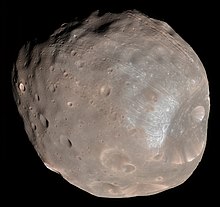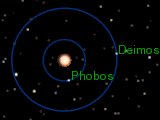Phobos (moon)
 Enhanced-color view of Phobos obtained by Mars Reconnaissance Orbiter on March 23 2008. | |
| Discovery | |
|---|---|
| Discovered by | Asaph Hall |
| Discovery date | August 18, 1877 |
| Orbital characteristics | |
| Epoch J2000 | |
| Periapsis | 9235.6 km |
| Apoapsis | 9518.8 km |
| 9377.2 km[1] | |
| Eccentricity | 0.0151 |
| 0.31891023 d (7 h 39.2 min) | |
Average orbital speed | 2.138 km/s |
| Inclination | 1.093° (to Mars's equator) 0.046° (to local Laplace plane) 26.04° (to the ecliptic) |
| Satellite of | Mars |
| Physical characteristics | |
| Dimensions | 26.8 × 22.4 × 18.4 km[2] |
Mean radius | 11.1 km[3] (0.0021 Earths) |
| ~6100 km² (11.9 µEarths) | |
| Volume | 5680 km³[4] (5.0 nEarths) |
| Mass | 1.072×1016 kg[5] (1.8 nEarths) |
Mean density | 1.887 g/cm³[4] |
| 0.0084–0.0019 m/s² (8.4-1.9 mm/s²) (860-190 µg) | |
| 11.3 m/s (40 km/h)[5] | |
| synchronous | |
Equatorial rotation velocity | 11.0 km/h (at longest axis' tips) |
| 0° | |
| Albedo | 0.071[3] |
| Temperature | ~233 K |
| 11.3[6] | |

Phobos (or Mars I) is one of Mars' moons. The other is Deimos.
Phobos is the larger of the two moons, and is only 27 kilometers in diameter. This is about as far as a car can travel on the highway in 15 minutes. It is covered with craters, as Earth's moon is.[7]
It is named after the god Phobos in Greek mythology. Its name means "fear".
Phobos is trapped in tidal drag, with its orbit lowering roughly 1.8 meters per century. In about 50 million years, Phobos will reach the Roche limit, where it is likely to be torn apart. Some fragments will fall on Mars and some will form a planetary ring or rings around Mars.
The other moon, Deimos, is the smaller of the two.
Spacecraft
[change | change source]The Soviet Union sent at least two space craft to this moon, Phobos 1 and Phobos 2. Both failed or lost contact with Earth, but Phobos 2 managed to take some pictures of the moon in 1989 before dying.
Features
[change | change source]There is one large crater on Phobos called Stickney. It is the size of the moon itself.
References
[change | change source]- ↑ "NASA Celestia". Archived from the original on 2005-03-09. Retrieved 2009-09-07.
- ↑ "Mars: Moons: Phobos". NASA Solar System Exploration. 2003-09-30. Archived from the original on 2014-06-24. Retrieved 2008-08-18.
- ↑ 3.0 3.1 "Planetary Satellite Physical Parameters". JPL (Solar System Dynamics). 2006-07-13. Retrieved 2008-01-29.
- ↑ 4.0 4.1 "Mars Express closes in on the origin of Mars' larger moon". DLR. 2008-10-16. Archived from the original on 2011-06-04. Retrieved 2008-10-16.
- ↑ 5.0 5.1 use a spherical radius of 11.1 km; volume of a sphere * density of 1.877 g/cm³ yields a mass (m=d*v) of 1.07×1016 kg and an escape velocity (sqrt((2*g*m)/r)) of 11.3 m/s (40 km/h)
- ↑ "Classic Satellites of the Solar System". Observatorio ARVAL. Retrieved 2007-09-28.
- ↑ Gater, Will (2009). Space 3D. Bristol Magazines. p. 67.


